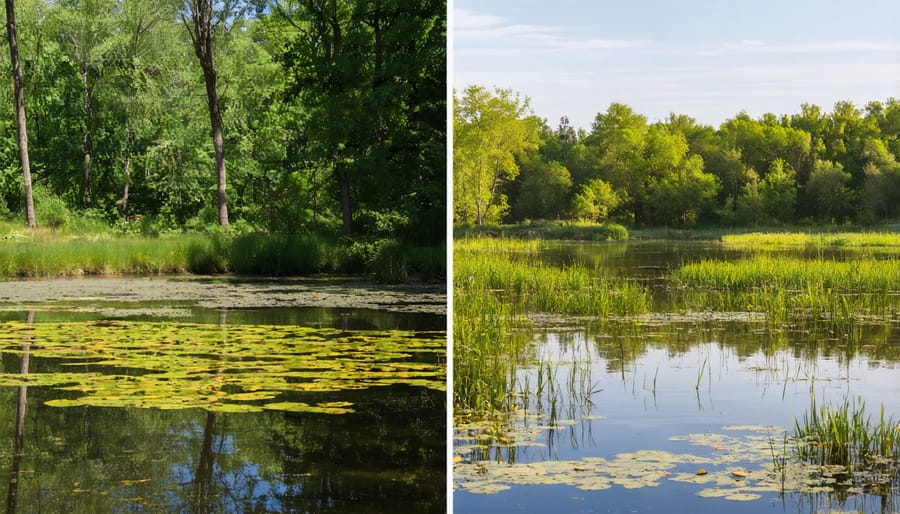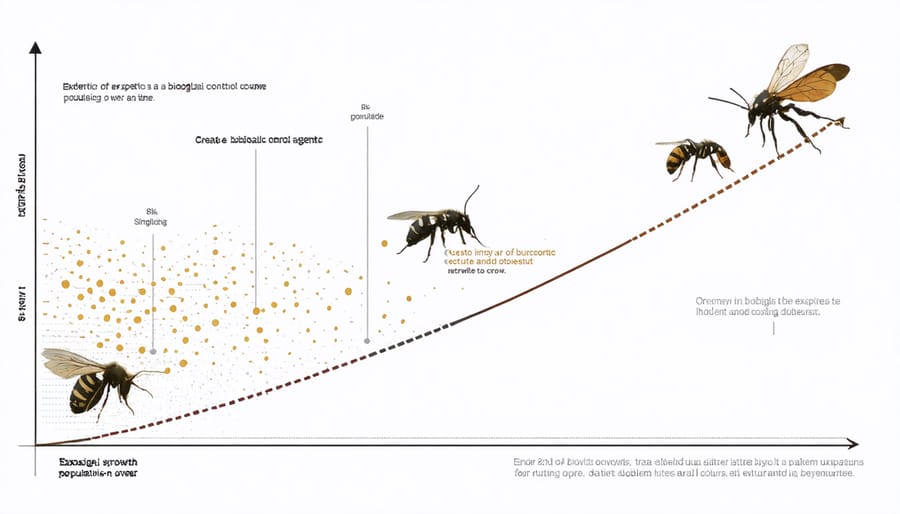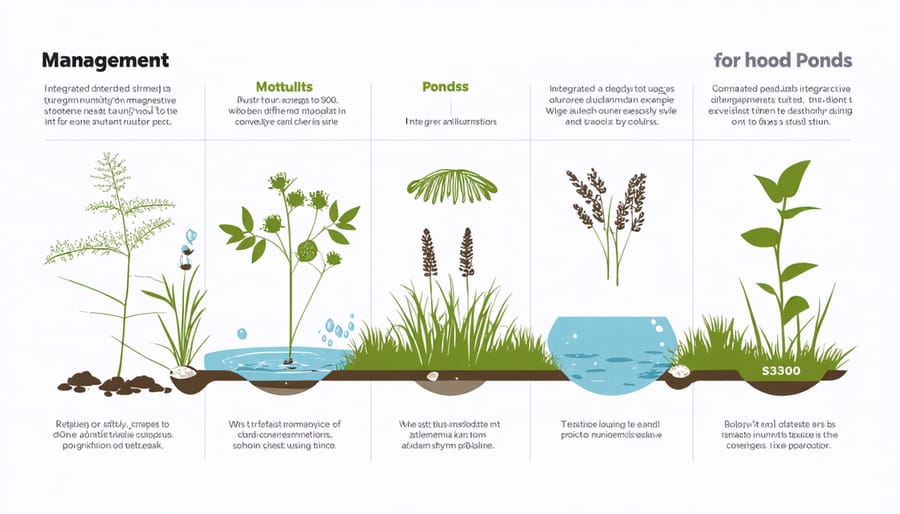
Why Biological Pond Pest Control Can Backfire (And What to Watch For)
Biological pest control, while celebrated as an eco-friendly alternative to chemical treatments, carries significant risks that pond owners must carefully consider. When introducing predatory species to control unwanted pests, the delicate balance of your pond’s ecosystem can be permanently altered. These natural control methods, though appealing for their organic approach, often come with unpredictable outcomes – from predators targeting beneficial species to the potential for introduced organisms to become invasive themselves.
The cost-effectiveness of biological control methods isn’t guaranteed either. Initial investments may seem reasonable, but the long-term maintenance and potential need for repeated introductions can strain budgets. Unlike chemical treatments that offer precise dosage control, biological agents can be challenging to manage once released, sometimes leading to population explosions or complete die-offs that leave your pond vulnerable to new pest problems.
Understanding these drawbacks isn’t meant to discourage the use of biological control entirely, but rather to emphasize the importance of thorough research and careful consideration before implementation.
Ecological Imbalance Issues
Predator Overpopulation
One of the trickiest challenges with biological pest control is that these helpful creatures can sometimes become too successful. Imagine releasing a few dragonfly nymphs to control mosquito larvae in your pond, only to find they’ve multiplied rapidly and are now consuming beneficial insects too. When predator populations grow beyond intended levels, they can disrupt the delicate balance of your pond ecosystem.
These control agents might start competing with other beneficial creatures for food and space, potentially causing unexpected problems. For instance, an overabundance of predatory insects might reduce the population of beneficial water bugs that help keep your pond clean. In some cases, these organisms might even move beyond your pond area, affecting nearby water features or natural waterways.
The most concerning aspect is that once predator populations explode, they’re incredibly difficult to manage. Unlike chemical treatments that can be measured and controlled, living organisms reproduce and spread naturally, making it challenging to maintain optimal population levels. This situation often requires additional intervention, which can be both time-consuming and costly to address.
Impact on Non-Target Species
One of the most concerning aspects of biological pest control is its potential impact on beneficial organisms that weren’t intended to be targeted. When introducing predatory species to control pests, these natural enemies might not discriminate between harmful and helpful creatures in your pond. For example, dragonfly larvae, while excellent at controlling mosquito populations, may also feed on small fish fry or beneficial aquatic insects that help maintain your pond’s ecosystem.
Native species can be particularly vulnerable to introduced biological control agents. Sometimes, these predators might prefer feeding on easier-to-catch beneficial insects rather than the targeted pests. This can disrupt the delicate balance of your pond’s food web and potentially create new problems while trying to solve existing ones.
Additionally, some biological control agents may compete with native species for resources like food and shelter, potentially pushing out the very creatures that naturally help maintain your pond’s health. This is why it’s crucial to thoroughly research and carefully consider the potential ecological impacts before introducing any new species for pest control.

Control and Management Challenges
Limited Control Options
One of the most challenging aspects of biological pest control is the limited ability to manage these living organisms once they’re introduced into your pond ecosystem. Unlike chemical treatments that can be diluted or neutralized, biological control agents often become permanent residents of your water feature. This can be particularly problematic if the biological control proves more aggressive than anticipated or if conditions change, making their presence less desirable for responsible aquatic management.
For example, if you introduce predatory fish to control mosquito larvae, you can’t simply “turn off” their appetite when mosquito populations decline. These fish might then switch to feeding on beneficial insects or even small ornamental fish fry. Similarly, beneficial bacteria and other microorganisms can multiply rapidly under favorable conditions, potentially affecting water chemistry and clarity.
Removing biological control agents often requires drastic measures like completely draining the pond or introducing additional controls, which can be time-consuming and potentially disruptive to your pond’s ecosystem. This lack of precise control means you’ll need to carefully consider the long-term implications before introducing any biological pest control methods to your water garden.

Seasonal Effectiveness Issues
One significant challenge of biological pest control is its heavy dependence on weather conditions and seasonal changes. Many beneficial organisms work best within specific temperature ranges and humidity levels, making their effectiveness unpredictable throughout the year. During colder months, most biological control agents become dormant or die off completely, leaving your pond vulnerable to pest problems.
These seasonal limitations mean you might need different control methods during various times of the year. For instance, beneficial nematodes that work wonderfully in spring might become ineffective during hot summer months. Similarly, predatory insects may migrate or become inactive during winter, leaving no protection against persistent pests.
Weather extremes can also impact biological control success. Heavy rains can wash away beneficial insects, while drought conditions might force them to seek better environments. This inconsistency in pest control can be particularly frustrating when dealing with year-round pest issues.
To maintain effective pest control, pond owners often need to reintroduce beneficial organisms multiple times throughout the year, which can be both time-consuming and costly. This seasonal variability means you’ll need to closely monitor your pond’s ecosystem and be prepared with backup control methods during less favorable conditions.
Cost Considerations
While biological pest control might seem like a cost-effective solution at first glance, it often comes with significant financial implications that many pond owners don’t initially consider. The upfront costs of purchasing beneficial organisms can be substantially higher than traditional chemical treatments. For instance, introducing predatory fish or beneficial insects might require multiple purchases throughout the season to maintain effective control.
The need for ongoing monitoring and maintenance can add unexpected expenses. You’ll likely need to invest in water testing equipment to ensure conditions remain suitable for your biological control agents. Additionally, if the beneficial organisms don’t establish themselves successfully, you may need to reintroduce them multiple times, multiplying the initial investment.
Environmental modifications required to support biological control agents can also drive up costs. This might include installing specific plants, creating shelter areas, or adjusting water features to maintain optimal conditions. Some biological control methods may require professional consultation, especially when dealing with complex pest problems or when introducing new species to your pond ecosystem.
There’s also the potential for indirect costs. If biological control methods prove less effective than anticipated, you might face expenses related to plant replacement or restoration of damaged areas. Furthermore, some beneficial organisms may require specific food sources during periods when target pests are scarce, adding to the ongoing maintenance costs.
While biological pest control can be environmentally friendly, it’s essential to carefully consider these financial aspects and perhaps maintain a contingency budget for unexpected challenges that may arise during implementation.

Alternative Solutions
While biological pest control has its drawbacks, there are several safer alternatives for pest control that pond owners can consider. A balanced approach often yields the best results, combining different methods to create an effective pest management strategy.
Physical barriers like pond netting can prevent unwanted visitors while allowing beneficial insects to thrive. These nets are particularly effective against predatory birds and can be easily installed or removed as needed. UV clarifiers offer another mechanical solution, helping to control algae and certain microscopic pests without introducing any organisms into your ecosystem.
Regular maintenance plays a crucial role in natural pest prevention. Removing debris, maintaining proper water circulation, and ensuring optimal filtration can significantly reduce pest problems before they begin. Adding appropriate plants around your pond creates natural barriers and can help maintain a healthy balance in your ecosystem.
Chemical alternatives have also evolved to become more eco-friendly. Modern pond treatments use natural enzymes and beneficial bacteria that target specific issues without the unpredictability of introducing live organisms. These treatments often come with clear dosage instructions and predictable results.
For those seeking a middle ground, integrated pest management (IPM) combines multiple approaches. This might include using biological controls selectively while maintaining other preventive measures. For example, you might use beneficial bacteria for water quality while employing physical barriers for larger pests.
Remember that different seasons may require different approaches. What works in summer might need adjustment in winter, so stay flexible with your pest management strategy. Regular monitoring of your pond’s conditions will help you adjust your approach as needed, ensuring the most effective and safe solution for your specific situation.
While biological pest control offers an eco-friendly approach to pond management, it’s essential to carefully consider its limitations and challenges before implementation. The slower action time, potential ecological impacts, and higher initial costs make it crucial to develop a balanced pest management strategy.
Consider starting with small-scale biological control measures while monitoring their effectiveness. Combine these methods with preventive practices like regular pond maintenance, proper filtration, and maintaining optimal water quality. If you’re new to biological control, consult with local pond experts or experienced water gardeners who can provide guidance based on your specific situation.
Remember that successful pest management often requires a multi-faceted approach. While biological control has its drawbacks, it can still be valuable as part of an integrated pest management system. Stay informed about new developments in biological control methods, and be prepared to adjust your strategy based on results and changing conditions in your pond ecosystem.
For best results, document your experiences, maintain detailed records of control measures used, and share insights with fellow pond enthusiasts to contribute to the growing knowledge base in natural pond management.
